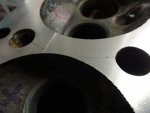There is a method of repair that has been used here for almost 50 years or longer called "stitch welding". Its funny because it doesn't involve welding at all, but is very effective, and was used to fix many Flathead Fords that were always cracking in the valve seat areas. It involves a series of small overlapping holes that are drilled starting at the beginning of the crack, or in your case, as close to the edge of the water port as you can. Then a tapered threaded plug the tapped and inserted into the hole, cut off flush with a hacksaw blade or cutoff wheel, then the next one is drilled tapped and threaded and cut flush, and the process continues slightly over lapping the last plug. Since it doesn't involve heating, welding or stressing the head in any way, it wont compromise any of the work you have already done, and only may require a slight resurface of a few thousandths to cut the cut off plugs stubs flush to the deck. It has even been used very successfully to repair cracked combustion chambers in many OHV engines. Its worth a try before you have the head all warped up from heating and welding and potentially lose all the work, time and money you all ready have invested at this point. Since that is really a pretty low stress area, I would give it a try.




